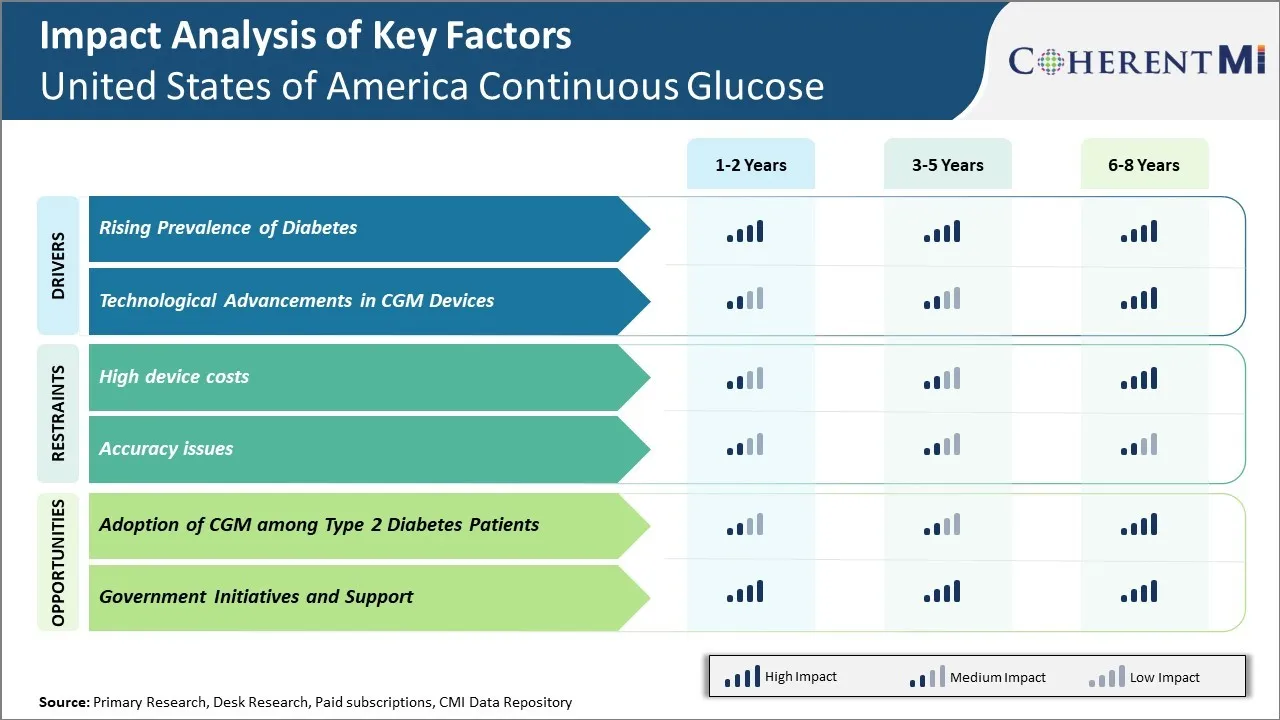미국 연속 포도당 모니터링 시장 크기 - 분석
USD 기준 시장 규모 Mn
CAGR8.8%
| 연구 기간 | 2025-2032 |
| 추정 기준 연도 | 2024 |
| CAGR | 8.8% |
| 시장 집중도 | Medium |
| 주요 플레이어 | 뚱 베어, (주)디렉스, 메트로닉, 센스로닉스, Inc., F. Hoffmann-La Roche 주식회사 및 기타 |
저희에게 알려주세요!
미국 연속 포도당 모니터링 시장 트렌드
시장 드라이버 - CGM 기기의 기술 발전
지속적인 포도당 감시 (CGM) 장치에 있는 기술적인 전진은 미국 CGM 시장의 성장을 두드러지게 연료를 공급합니다. 현재 사용할 수있는 고급 CGM 시스템은 당뇨병 환자에게 전통적인 손가락 스틱 모니터링에 충분한 혜택을 제공합니다. 이 장치에서 실시간 포도당 독서는 개량한 당뇨병 관리 및 도움 환자가 그들의 혈당 수준을 통제하는 것을 가능하게 합니다.
최신 CGM 기술 중 일부는 고급 경고 및 경보와 같은 최첨단 기능을 통합합니다. 이것은 적시 개입을 촉진하고 잠재적으로 생명을 위협하는 포도당 변동의 위험을 감소시킵니다. 스마트 폰 호환 CGM 기기의 가용성은 더욱 향상된 편의성을 가지고 있습니다. 환자는 하루에 걸쳐 휴대 전화에서 glucose 데이터 및 트렌드를 쉽게 볼 수 있습니다. 이 유형의 사용자 친화적 인 연결은 증가 장치 사용 및 치료 준수를 촉진합니다.
질병 통제 및 예방 센터 (CDC)에 따르면 미국 인구의 거의 14%는 2018 년 당뇨병으로 진단되었습니다. CGM 기능 및 접근성의 발전과 결합 된이 만성 상태의 성장률은 고도화 된 수요를 연료화합니다. 이 급속한 발달 및 혁신적인 CGM 공구의 채택은 오는 년에 있는 미국 시장의 지속적인 확장을 몰기 위하여 계획됩니다.

시장 기회 - 유형 2 당뇨병 환자 중 CGM의 채택
연속 포도당 모니터링 (CGM)의 채택은 미국에서 2 형 당뇨병 환자 중 주요 성장 기회를 제공합니다. 전국 당뇨병의 모든 진단 된 성인 사례의 90-95%에 대한 2 형 당뇨병 계정. 질병 통제 및 예방 센터 (CDC)에 따라 37 만 명의 미국인이 2021 년으로 당뇨병을 앓고있는 것으로 추정되며, 향후 몇 년 동안 인구를 크게 증가시키고 비만과 세분화 생활 습관의 조기 증가로 예상됩니다. CGM은 하루와 밤 동안 실시간 포도당 독서를 제공합니다. 환자를위한 혈당 수준의 더 나은 관리를 할 수 있습니다.
유형 2 환자 중 CGM의 Wider 채택은 미국 당뇨병 관리와 관련된 상승 의료비를 촉발시킬 수 있습니다. 왼 uncontrolled, 높은 혈당은 광대한 의학 처리를 요구하는 심각한 건강 문제점을 일으킬 수 있습니다. 미국 당뇨병 협회 (American Diabetes Association)의 데이터는 당뇨병 관련 직접 의료 비용은 2017 년 327 억 달러로 추정되었으며, 2 명의 회계를 보유하고 있습니다. CGM은 환자와 의사가 적시 치료 조정을 만들기에 도움이되며, 하이퍼 / hypoglycemic 이벤트 및 긴 실행에 관련된 물리적 / 금융 부담을 방지합니다.
경쟁 개요 미국 연속 포도당 모니터링 시장
미국 지속 포도당 모니터링 시장에서 운영되는 주요 플레이어는 Abbott, Dexcom, Inc., Medtronic, Senseonics, Inc., F. Hoffmann-La Roche Ltd., GLUCOVATION, INC., Nemaura Medical Inc., GlySens, GlucoModicum 및 Signos, Inc.를 포함합니다.
미국 연속 포도당 모니터링 시장 선두
- 뚱 베어
- (주)디렉스
- 메트로닉
- 센스로닉스, Inc.
- F. Hoffmann-La Roche 주식회사
미국 연속 포도당 모니터링 시장 - 경쟁 경쟁

미국 연속 포도당 모니터링 시장
(주요 플레이어가 지배)
(많은 플레이어가 있는 매우 경쟁적)
최근 개발 미국 연속 포도당 모니터링 시장
- Senseonics Holdings, Inc., 장기 개발 및 제조에 초점을 맞춘 의료 기술 회사 인 Senseonics Holdings는 당뇨병 환자를 위한 지속적인 포도당 감시 (CGM) 체계, 미국 음식과 약국 (FDA)에 의하여 차세대 Eversense E3 CGM 체계의 승인을 발표했습니다.
미국 연속 포도당 모니터링 시장 세분화
- 회사연혁
- 센서
- 송신기 및 수신기
- 통합시스템
- 이름 *
- 에 의해 Demographic
- 성인 (18-65)
- 석고 (65 +)
- 소아과 / Teenagers
- 으로 표시
- 유형 1 당뇨병
- Gestational 당뇨병
- 유형 2 당뇨병
- 이름 *
- End-User에 의해
- 병원소개
- 홈 케어
- 진료시간
- Nursing 홈
- 이름 *

구매 옵션을 알아보시겠어요?이 보고서의 개별 섹션?
마니샤 비부테는 시장 조사 및 컨설팅 분야에서 5년 이상의 경험을 가진 컨설턴트입니다. 시장 역학에 대한 강력한 이해를 바탕으로 마니샤는 고객이 효과적인 시장 접근 전략을 개발하도록 지원합니다. 그녀는 의료 기기 회사가 가격 책정, 환불 및 규제 경로를 탐색하여 성공적인 제품 출시를 보장하도록 돕습니다.
자주 묻는 질문 :
미국의 지속적인 포도당 감시 시장의 성장을 침수하는 중요한 요인은 무엇입니까?
높은 장치 비용과 정확도 문제는 미국 지속 포도당 모니터링 시장의 성장 hampering 주요 요인입니다.
미국의 지속 포도당 모니터링 시장 성장의 미국을 운전하는 주요 요인은 무엇입니까?
CGM 기기의 당뇨병 및 기술 발전의 상승률은 미국 지속 포도당 모니터링 시장 성장을 주도하는 주요 요인입니다.
미국 지속 포도당 모니터링 시장에서 선도적 인 구성 요소는 무엇입니까?
주요 부품 세그먼트는 센서입니다.
미국 지속 포도당 모니터링 시장에서 운영되는 주요 선수는 무엇입니까?
Abbott, Dexcom, Inc., Medtronic, Senseonics, Inc., F. Hoffmann-La Roche Ltd., GLUCOVATION, INC., Nemaura Medical Inc., GlySens, GlucoModicum 및 Signos, Inc.는 주요 선수입니다.
미국의 지속 포도당 모니터링 시장의 CAGR 무엇입니까?
미국의 지속적인 포도당 모니터링 시장의 CAGR는 2024-2031에서 8.6%가 될 것으로 예상됩니다.